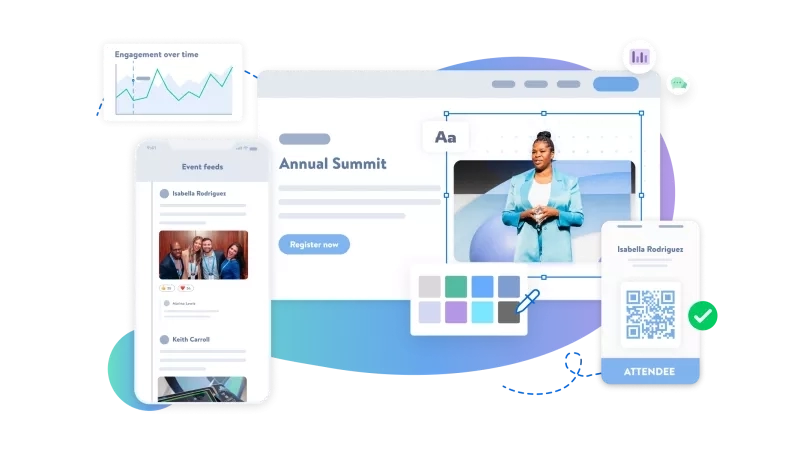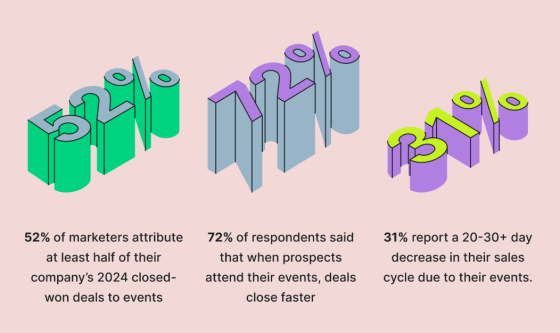Micro events may be small, but they can have a big impact. These intimate gatherings are proving to be one of the most effective ways to spark engagement, build trust, and accelerate deals.
However, just because they’re smaller doesn’t mean they’re any easier to run. In fact, staging micro events consistently can take just as much planning as a larger conference, especially without the right systems in place. To get results, you need a clear framework and the right tools to make them repeatable without overloading your team.
Read on to learn why micro events are on the rise, how to use them to build stronger relationships, and how to create a repeatable program that drives real impact.
What are micro events?
Micro events are repeatable, consistent, and adaptable formats that typically host between 10 and 50 people. They may last only a few hours or half a day. They focus on specific topics or goals, and excel in moving customers through your marketing funnel and closing deals.
According to ‘An Outlook on Events 2025’ report from Splash, 52% of marketers credit at least half of their company’s 2024 closed-won deals to these types of events. Plus, 72% of respondents stated that when prospects attend their events, deals close more quickly, and 31% reported a 20-30+ day reduction in their sales cycle due to their events.
As a result, three out of four marketers (72%) now state that events are their company’s most effective marketing channel.
Why are micro events on the rise?
In 2023, the average marketing team hosted 14 events. In 2024, that number more than doubled to 29. As a result, 69% of marketers say their company plans to increase its total marketing budget, and more than half (55%) say that at least 20% will be allocated to events.
Micro events contribute significantly to this rise as more organizations adopt an event-led growth strategy. The benefits include:
Greater flexibility
Let’s face it, organizing a 500-person conference is like steering a massive ship — it's impressive when it succeeds, but difficult to change course. Micro events resemble speedboats. Need to postpone due to bad weather? Want to make last-minute changes? With smaller numbers, adjustments are easier.
Unlike flagship conferences that demand long planning cycles, micro events can be repeated, adapted, and scaled with relative ease. This flexibility enables you to respond quickly to changing priorities, market trends, or audience needs.
More cost-effective
Micro events require far less spend than large-scale conferences. Without the overheads of hiring larger venues, staging elaborate productions, or managing extensive logistics, organizations can host small, targeted experiences at a fraction of the cost. It makes them more financially accessible for businesses of all sizes and provides a lower-risk way to test formats, audiences, or ideas before committing to a larger investment.
Accelerated deal cycles
Sales teams, in particular, benefit from the intimacy of small-group settings such as private dinners, seminars, or roundtables. These environments create the trust and focus needed for more in-depth conversations, helping to move prospects through the pipeline faster than at larger, more impersonal gatherings. By facilitating authentic engagement, micro events turn networking into relationship-building, and relationships into results.
More opportunity for personalization
Today’s audiences expect content tailored specifically to their interests and needs, so staging multiple smaller events allows you to be more targeted and create personalized experiences that truly matter.
Instead of adhering to rigid plans, you can follow the energy of the room and explore topics that spark real interest. This responsive approach transforms standard meetings into lively sessions where authentic learning and connection occur naturally.
“Personalization in the buyer journey may feel tough to weave into a repeatable events program. However, when you lean into a scalable program with really clear playbooks, you gain back time, which allows you to layer in personalization. Your audience doesn’t care how many times you run the event; they care that it feels relevant to them.”
Camille Arnold - Senior Manager, Industry Solutions, Cvent
Deeper connections
With fewer people in the room, conversations are more genuine and less transactional, allowing attendees to move beyond surface-level networking and form deeper, more meaningful connections.
Micro events create space for everyone to be seen and heard, encouraging richer dialogue, collaboration, and a stronger sense of community. Instead of feeling lost in the crowd, participants can engage in focused discussions, share experiences, and build relationships that last long after the event ends.
Tips for staging micro events
“Repeatable events are consistent across format and flow, the tools and techniques you use to execute them and the data reporting used to measure them. Allow space to adapt based on audience feedback and insights. Consistency can help you build recognition, but adaptability and evolution are what keep you relevant. Your event programs should have a healthy balance of both.”
Zach Napolitano - Senior Manager, Product Marketing, Cvent
For a successful events-led growth strategy, you need repeatable micro events that cover the entire marketing funnel.
Some of your events will generate demand by attracting and nurturing prospects. Others will capture demand by closing deals or sustain demand by renewing customers and fostering loyalty.
Types of micro events
Here are some examples of smaller, repeatable event types:
- Marketing events: Focused on education and thought leadership, these are designed to attract and nurture prospects. You might host regular in-person networking events, fireside chats with industry experts, seminars, or virtual formats like webinars.
- Sales events: These are often customized experiences designed to move deals forward. Examples include executive roundtables, VIP events, or even workshops.
- Customer events: These provide a great opportunity to engage with current or returning customers. You might reward loyalty with an incentive or hospitality event, or encourage product adoption through user groups and customer advisory boards.
- Third-party events: These might include your attendance at industry trade shows or sponsored workshops and roundtables organized by an external organization. If your aim is brand awareness or expanding your pipeline, participating in third-party events will be beneficial.
5 tips for mastering your small, repeatable events
1. Design your framework
Bring together key stakeholders from sales, marketing, product, and leadership to align on event objectives and review your activities. You need to understand what’s currently effective and what’s not, based on your goals. This will help you identify opportunities, determine which parts of the funnel require additional events, and pinpoint scalable event formats to move customers through the pipeline and close deals.
For example, are your ‘top of the funnel’ events boosting brand awareness and generating initial interest? Do you need more ‘middle of the funnel’ activities to nurture leads and guide them towards making a decision? What events are you using to close deals, drive revenue, and convert leads into customers?
By mapping the right event to the right challenge and the right audience, at the right time, you can create a highly effective framework.
2. Choose your formats
Create appropriate formats considering audience size, content depth, interactivity levels, and available resources.
To build more personal connections with targeted prospects, consider arranging multiple meetings for small groups, for example. If you need additional product demonstrations or presentations, make sure they are carefully scripted with rehearsed interactive points so they can be easily repeated and hosted by various team members.
The amount of time, budget, and internal resources available will determine which micro event formats are scalable, impactful, and easy to replicate.
Monthly networking dinners that don’t require detailed presentations, for example, will help you nurture prospects and stimulate conversations.Quarterly webinar product updates, however, require fewer event management resources but will assist you in building your user community.
💡Top tip: Focus on mastering one or two micro event formats at a time and gradually develop your events-led growth program step-by-step. Only after your initial formats are operational and meeting your objectives should you consider introducing additional formats.
3. Create your templates
Introducing both design and workflow templates means you won't need to start from scratch each time you add an event to your program.
Workflow templates detailing pre-, during, and post-event attendee touchpoints throughout the event lifecycle will reduce your set-up time, minimize errors, assist with task delegation, and enable easier scaling. Build them once and reuse frequently.
Event technology, meanwhile, is essential for designing templates. Website landing pages, event registration forms, invites, marketing, and follow-up emails can all be duplicated, automated, and cloned to reduce the workload of organizing repeatable events.
Pre-approved templates also guarantee each touchpoint aligns with your brand guidelines, while data privacy templates assist you in remaining compliant with regulations such as GDPR or CCPA, avoiding errors and risky practices.
4. Standardize your operations
You’ve secured your formats and prepared your templates, but if your behind-the-scenes operations are chaotic, you’ll soon hit a wall when trying to scale your events.
To minimize frictions and enhance collaboration with your sales team, consider defining and standardizing the following:
- Team roles and responsibilities
- Event formats that lend themselves to repeatability and standardization
- Your event tech stack integration with your marketing CRM
- Lead handoff and follow-up.
💡 Top tip: - Cvent’s Senior Manager, Product Marketing, Zach Napolitano, recommends halving your preparation time each time you repeat an event as a good standardization benchmark. Over time, repeatable events should become consistently easier for you to create, launch, and promote.
5. Prove the impact
An event technology dashboard enables you to track the success of each event and optimize it as you go. Additionally, integrations with your CRM, MAP, and other MarTech platforms provide a complete view of your event data and its impact.
Measure lead generation KPIs such as new leads acquired, meetings booked, and leads reactivated by your event. For opportunity generation, track the pipeline generated by each event and the average contract value of opportunities.
If your event is aimed at driving sales or closing deals, calculate the average and median lead-to-opportunity and opportunity-to-close times, and compare them with those of someone who does not attend your events.
Explore Cvent Essentials for scaling your micro event programs. Tour our interactive demo or schedule a personalized one.
FAQs
Here are the answers to three popular questions to get you started on a successful events-led growth program.
How do you measure the success of a small event?
A successful small event provides clear value to all attendees, making post-event feedback essential. Every stage of your marketing funnel should be used to evaluate performance outcomes. If your event targets Top-of-Funnel, how many new leads or follow-up meetings has it generated? For Middle-of-Funnel, assess opportunities created and pipeline growth. If your aim is to close deals and increase revenue, how do the results compare with non-event-related sales activities?
What's the best way to choose between a larger event and several micro events?
Consider your event goals. If you need to reach many people with the same message, a larger event might work better. But if you want deep engagement, learning, or relationship building, personalized micro-events will likely work better.
What role does event technology play in micro events?
Tools and templates that help you scale more consistent, repeatable events and track the metrics most important to you are a fundamental part of any events-led growth strategy.
Master the repeatable events formula
Micro events are proving to be a powerful way to keep audiences engaged, build stronger relationships, and drive results without the heavy lift of a major conference. Their repeatable, focused format makes it easier to win new business, deepen loyalty, and keep your brand front of mind all year round.
Put simply: if you want your events to deliver real impact, it’s time to make micro events the engine of your growth strategy.
Check out our step-by-step checklist for running small, repeatable events (without the stress).













